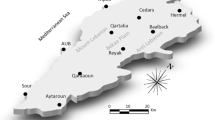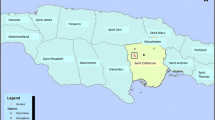Abstract
Water management in Saudi Arabia is facing major challenges due to the limited water resources and increasing uncertainties caused by climate change. The rainfall and temperature records of the Saudi meteorological data for more than three decades were analyzed for policy suggestions in water sectors based on the changing rainfall patterns. The trends in the annual aridity and rain indices were also examined to define the changing climate conditions and for determining the dry months in different cities of the Kingdom. An increased annual and maximum rainfall was observed for six cities while a decreasing trend in both annual and maximum rainfall was observed for the same number of cities highlighting the variability of rainfall in the whole region. An increasing maximum rainfall with decreasing annual rainfall was observed for the rest of the cities signifying the more extreme rainfall evens and resulting floods of short durations. The changing rainfall trends were also observed for different months during 31 years of the recorded period in addition to the varying climate pattern for different cities within the same district. Finally, these preliminary assessments of any systematic changes in view of the increased rain intensities and extreme climate events are viewed to demonstrate the value rainwater harvesting and management as a local adaptation to the climate variability and extreme in the Kingdom.







Similar content being viewed by others
References
Abdelkhaleq RA, Ahmed IA (2007) Rainwater harvesting in ancient civilizations in Jordan. Water Sci Technol 7:85–93
AlJazeera (2011) Floods inundate Saudi city. AlJazeera. http://english.aljazeera.net/news/middleeast/2011/01/2011127133721334153.html. Accessed 27 Jan
Alkolibi FM (2002) Possible effects of global warming on agriculture and water resources in Saudi Arabia. Impacts and responses. Clim Change 54:225–245
Al-Muttair FF, Sendil U, Al-Turbak AS (1994) Management of recharge dams in Saudi Arabia. J Water Resour Plan Manag 120(6):749–763
Amin MT, Han M (2007) Scope/need of soft path water resource management in developing countries. Water Sci Technol Water Supply 7(5–6):185–192
Amin MT, Han MY (2009a) Roof-harvested rainwater for potable purposes—application of solar disinfection (SODIS) and limitations. Water Sci Technol 60(2):419–431
Amin MT, Han MY (2009b) Water environmental and sanitation status in disaster relief of Pakistan’s 2005 earthquake. Desalination 248:436–445
Amin MT, Han MY (2009c) Roof-harvested rainwater for potable purposes. Application of solar collector disinfection (SOCO-DIS). Water Res 43:5225–5235
Amin MT, Han MY (2011) Improvement of solar based rainwater disinfection by using lemon and vinegar as catalysts. Desalination 276:416–424
Arnbjerg-Nielsen K, Fleischer HS (2009) Feasible adaptation strategies for increased risk of flooding in cities due to climate change. Water Sci Technol 60(2):273–281
Baguma D, Loisk LW, Jung H (2010) Water management, rainwater harvesting and predictive variables in rural households. Water Resour Manag 24(13):3333–3348
Balooni K, Kalro AH, Kamalamma AG (2008) Community initiatives in building and managing temporary check-dams across seasonal streams for water harvesting in south India. Agric Water Manag 95:1314–1322
Critchley W, Siegert K (1991) A manual for the design and construction of water harvesting schemes for plant production. Food and Agriculture Organization of the United Nations, Rome. http://www.fao.org/docrep/U3160E/u3160e00.HTM
Dillaha TA, Zolan WJ (1985) Rainwater catchment water quality in Micronesia. Water Res 19(6):741–746
El Atta HA, Aref I (2010) Effect of terracing on rainwater harvesting and growth of Juniperus procera Hochst. ex Endlicher. Int J Environ Sci Technol 7(1):59–66
Elagib NA, Addin Abdu AS (1997) Climate variability and aridity in Bahrain. J Arid Environ 36:405–419
ElNesr MN, Alazba AA, Abu-Zreig M (2010) Spatio-temporal variability of evapotranspiration over the Kingdom of Saudi Arabia. Appl Eng Agric 26(5):833–842
Fane S, Turner A (2010) Integrated water resource planning in the context of climate uncertainty. Water Sci Technol Water Supply 10(4):487–494
Ferrari MR, Miller JR, Russell GL (1999) Modeling the effect of wetlands. Flooding, and irrigation on river flow. Application to the Aral Sea. Water Resour Res 35:1869–1876
Ghisi E, Ferreira DF (2007) Potential for potable water savings by using rainwater and greywater in a multi-storey residential building in southern Brazil. Build Environ 2512:22–42
Grandet C, Binning PJ, Mikkelsen PS, Blanchet F (2010) Effects of rainwater harvesting on centralized urban water supply systems. Water Sci Technol Water Supply 10(4):570–576
Han MY (2007) Rainwater’s recovery role in Banda Aceh. Water 21:47–49
Han MY, Mun JS (2008) Particle behavior consideration to maximize the settling capacity of rainwater storage tanks. Water Sci Technol 56(11):73–79
Handia L, Tembo JM, Mwiindwa C (2003) Potential of water harvesting in urban Zambia. Phys Chem Earth 28:893–896
Hansen J, Sato MKI, Glascoe J, Ruedy R (1998) A common sense climate index: is climate changing noticeably? Proc Natl Acad Sci USA 95:4113–4120
Hatibu N, Mutabazi K, Senkondo EM, Msangi ASK (2006) Economics of rainwater harvesting for crop enterprises in semi-arid areas of East Africa. Agric Water Manag 74:80–86
Heyworth JS, Glonek G, Maynard EJ, Baghurst PA, Finlay-Jones J (2006) Consumption of untreated tank rainwater and gastroenteritis among young children in South Australia. Int J Epidemiol 35:1051–1058
Ibrahim MB (2009) Rainwater harvesting for urban areas: a success story from Gadarif city in Central Sudan. Water Resour Manag 23:2727–2736
Jackson RB, Carpenter SR, Dahm CN, McKnight DM, Naiman RJ, Postel SL, Running SW (2001) Water in a changing world. Ecol Appl 11:1027–1045
Kamil MW (1983) Climate and meteorology, Syria. University of Halab Publications, Damascus, p 386 (in Arabic)
Kleidorfer M, Möderl M, Sitzenfrei R, Urich C, Rauch W (2009) A case independent approach on the impact of climate change effects on combined sewer system performance. Water Sci Technol 60(6):1555–1564
Kumar MD (2004) Roof water harvesting for domestic water security: who gains and who loses? Water Int 39(1):43–53
Lumsden TG, Schulze RE, Hewitson BC (2009) Evaluation of potential changes in hydrologically relevant statistics of rainfall in Southern Africa under conditions of climate change. Water SA 35(5):649–656
Meera V, Ahammed MM (2006) Water quality of rooftop rainwater harvesting systems: a review. Water Supply Res Technol AQUA 55:257–268
Mintzer IM (1993) Confronting climatic change: risks. Implications, and Responses. Cambridge University Press, London
Montgomery DC, Peck EA, Vining GG (2001) Introduction to linear regression analysis, 3rd edn. Wiley, New York
Mukheibir P (2007) Qualitative assessment of municipal water resource management strategies under climate impacts: the case of the Northern Cape, South Africa. Water SA 33(4):575–581
Murad AA, Al Nuaimi H, Al Hammadi M (2007) Comprehensive assessment of water resources in the United Arab Emirates (UEA). Water Resour Manag. 21:1449–1456
Nazer DW, Siebel MA, Zaag PV, Mimi Z, Gijzen HJ (2010) A financial, environmental and social evaluation of domestic water management options in the West Bank. Palest Water Resour Manag 24:4445–4467
Olem H, Berthouex PM (1989) Acidic deposition and cistern drinking water supplies. Environ Sci Technol 23:333–340
Pandey DN, Gupta AK, Anderson DM (2003) Rainwater harvesting as an adaptation to climate change. Curr Sci 85(1):6–59
Parry AH (1986) Precipitation and climatic changes in Central Sudan. In: Rural development in the White Nile Province. Sudan. A study on interaction between man and natural resources. The United Nations University, Tokyo, pp 33–42
Pinfold JV, Horan NJ, Wirojanarud W, Mara D (1993) The bacteriological quality of rain jar water in rural northeast Thailand. Water Res 27(2):297–302
Postel SL, Daily GC, Ehrlich PR (1996) Human appropriation of renewable fresh water. Science 271:785–788
Preul HC (1994) Rainfall-runoff water harvesting prospects for greater Amman and Jordan. Water Int 19(2):82–85
Radif AA (1999) Integrated water resources management (IWRM): an approach to face the challenges of the next century and to avert future crises. Desalination 124:145–153
Raju NJ, Reddy TVK, Munirathnam P (2006) Subsurface dams to harvest rainwater—a case study of the Swarnamukhi River basin. Southern India. Hydrogeol J 14(4):526–531
Retamal M, Turner A (2010) Unpacking the energy implications of distributed water infrastructure: how are rainwater systems performing? Water Sci Technol Water Supply 10(4):546–553
Savin NE, White KJ (1977) The Durbin–Watson test for serial correlation with extreme sample sizes or many regressors. Econometrica 45:1989–1996
Schmandt J, Clarkson J (1992) The regions and global warming: impacts and response strategies. Oxford University Press, NY
Sendil U, Al-Turbak AS, Al-Muttair FF (1990) Management plans for artificial reservoir recharge. Int J Water Resour Dev 6(3):163–169
Simmons G, Hope V, Lewis G, Whitmore J, Gao W (2001) Contamination of potable roof-collected rainwater in Auckland. N Z Water Res 35(6):1518–1524
Smith B, Dennis T (1989) The potential effect of global climate change, a report to the congress of the US EPA. pp 166–185
Spinks AT, Dunstan RH, Harrison T, Coombes PJ, Kuczera G (2006) Thermal inactivation of water-borne pathogenic and indicator bacteria at sub-boiling temperatures. Water Res 40(6):1326–1332
Sturm M, Zimmermann M, Schutz K, Urban W, Hartung H (2009) Rainwater harvesting as an alternative water resource in rural sites in central northern Namibia. Phys Chem Earth 34:776–785
Thomas T (1998) Domestic water supply using rainwater harvesting. Build Res Inform 26(2):94–101
UNESCO (1977) Map of the world distribution of arid regions. MAB Technical Notes 7. United Nations Educational Scientific and Cultural Organization, New York, pp 11–13
Van Wageningen A, Du Plessis JA (2008) Are rainfall intensities changing, could climate change be blamed and what could be the impact for hydrologist? Water SA 33:571–574
Zhang Y, Grant A, Sharma A, Chen D, Chen L (2010) Alternative water resources for rural residential development in Western Australia. Water Resour Manag 24:25–36
Acknowledgments
The authors wish to express their deep thanks and gratitude to “Shaikh Mohammad Bin Husain Alamoudi” for his kind financial support to the King Saud University, http://www.ksu.edu.sa, through the research chair “Shaikh Mohammad Alamoudi Chair for Water Researches” (ACW), http://awc.ksu.edu.sa, where this study is part of the AWC chair activities in the “Projects and Research” axis. Thanks should also be expressed to the Presidency of Meteorology and Environment in Riyadh, KSA, who kindly provided the meteorological data.
Author information
Authors and Affiliations
Corresponding author
Rights and permissions
About this article
Cite this article
Amin, M.T., Alazba, A.A. & ElNesr, M.N. Adaptation of climate variability/extreme in arid environment of the Arabian peninsula by rainwater harvesting and management. Int. J. Environ. Sci. Technol. 10, 27–36 (2013). https://doi.org/10.1007/s13762-012-0096-9
Received:
Revised:
Accepted:
Published:
Issue Date:
DOI: https://doi.org/10.1007/s13762-012-0096-9




